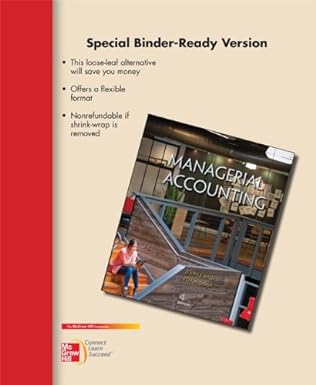Answered step by step
Verified Expert Solution
Question
1 Approved Answer
PR 9-1A Entries related to uncollectible accounts The following transactions were completed by the Emmanuel Company during the current fiscal year ended December 31: Jan.
PR 9-1A Entries related to uncollectible accounts The following transactions were completed by the Emmanuel Company during the current fiscal year ended December 31: Jan. 29. Received 40% of the $17,000 balance owed by the Jankovich Co., a bankrupt business, and wrote off the remainder as uncollectible. Apr. 18. Reinstated the account of Vince Karm, which had been written off in the preceding year as uncollectible. Journalized the receipt of $7,560 cash in full payment of Karm's account. Aug. 9. Wrote off the $22,380 balance owed by the Golden Stallion Co., which has no assets. Nov. 7. Reinstated the account of Wiley Co., which had been written off in the preceding year as uncollectible. Journalized the receipt of $13,220 cash in full payment of the account. Dec. 31. Wrote off the following accounts as uncollectible (compound entry): Claire Moon, Inc., $22,860; Jet Set Co., $15,320; Randall Distributors, $41,460; Harmonic Audio, $18,890. Dec. 31. Based on an analysis of the $2,740,000 of accounts receivable, it was estimated that $113,330 will be uncollectible. Journalized the adjusting entry. Instructions 1. Record the January 1 credit balance of $102,380 in a T account for Allowance for Doubtful Accounts. 2. Journalize the transactions. Post each entry that affects the following selected T accounts and determine the new balances: Allowance for Doubtful Accounts Bad Debt Expense. 3. Determine the expected net realizable value of the accounts receivable as of December 31. 4. Assuming that instead of basing the provision for uncollectible accounts on an analysis of receivables, the adjusting entry on December 31 had been based on an estimated expense of 1/2 of 1% of the sales of $24,900,000 for the year, determine the following: a. Bad debt expense for the year. b. Balance in the allowance account after the adjustment of December 31. c. Expected net realizable value of the accounts receivable as of December 31. PR 9-2A Aging of receivables; estimating allowance for doubtful accounts Trophy Fish Company supplies flies and fishing gear to sporting goods stores and outfitters throughout the western United States. The accounts receivable | clerk for Trophy Fish prepared the following partially completed aging of receivables schedule as of the end of business on December 31, 2015: A 1 2 3 Customer 4 AAA Outfitters 5 Brown Trout Fly Shop B C DE Not F Days Past Due G H Past Balance Due 1-30 31-60 61-90 91-120 Over 120 20,000 20,000 7,500 7,500 30 Zigs Fish Adventures 31 Subtotals Figure 1 4,000 4,000 1,300,000 750,000 290,000 120,000 40,000 20,000 The following accounts were unintentionally omitted from the aging schedule: 80,000 The following accounts were unintentionally omitted from the aging schedule: Customer Due Date Balance Adams Sports & Flies May 22, 2015 $5,000 Blue Dun Flies Oct. 10, 2015 4,900 Cicada Fish Co. Sept. 29, 2015 8,400 Deschutes Sports Oct. 20, 2015 7,000 Green River Sports Nov. 7, 2015 3,500 Smith River Co. Nov. 28, 2015 2,400 Western Trout Company Dec. 7, 2015 6,800 Wolfe Sports Jan. 20, 2016 4,400 Trophy Fish has a past history of uncollectible accounts by age category, as follows: Age Class Not past due Percent Uncollectible 1% 1-30 days past due 2 31-60 days past due 10 61-90 days past due 30 91-120 days past due 40 Over 120 days past due 80 Instructions 1. Determine the number of days past due for each of the preceding accounts. 2. Complete the aging of receivables schedule by adding the omitted accounts to the bottom of the schedule and updating the totals. 3. Estimate the allowance for doubtful accounts, based on the aging of receivables schedule. 4. Assume that the allowance for doubtful accounts for Trophy Fish Company has a debit balance of $3,600 before adjustment on December 31, 2015. Journalize the adjusting entry for uncollectible accounts. PR 9-6A Sales and notes receivable transactions The following were selected from among the transactions completed by Caldemeyer Co. during the current year. Caldemeyer Co. sells and installs home and business security systems. Jan. 3. Loaned $18,000 cash to Trina Gelhaus, receiving a 90-day, 8% note. Feb. 10. Sold merchandise on account to Bradford & Co., $24,000. The cost of the merchandise sold was $14,400. Feb. 13. Sold merchandise on account to Dry Creek Co., $60,000. The cost of merchandise sold was $54,000. Mar. 12. Accepted a 60-day, 7% note for $24,000 from Bradford & Co. on account. Mar. 14. Accepted a 60-day, 9% note for $60,000 from Dry Creek Co. on account. Apr. 3. Received the interest due from Trina Gelhaus and a new 120-day, 9% note as a renewal of the loan of January 3. (Record both the debit and the credit to the notes receivable account.) May 11Received from Bradford & Co. the amount due on the note of March 12. May 13. Dry Creek Co. dishonored its note dated March 14. July 12. Received from Dry Creek Co. the amount owed on the dishonored note, plus interest for 60 days at 12% computed on the maturity value of the note. Aug. 1. Received from Trina Gelhaus the amount due on her note of April 3. Oct. 5. Sold merchandise on account to Halloran Co., $13,500. The cost of the merchandise sold was $8,100. Oct. 15. Received from Halloran Co. the amount of the invoice of October 5, less 2% discount. Instructions Journalize the entries to record the transactions
Step by Step Solution
There are 3 Steps involved in it
Step: 1

Get Instant Access to Expert-Tailored Solutions
See step-by-step solutions with expert insights and AI powered tools for academic success
Step: 2

Step: 3

Ace Your Homework with AI
Get the answers you need in no time with our AI-driven, step-by-step assistance
Get Started


